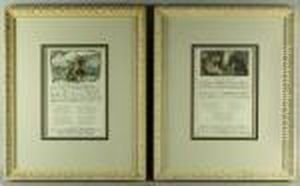Georges I Bickham Paintings
Georges I Bickham was an English engraver and printmaker, known primarily for his work in the first half of the 18th century. Although his exact birth date is not recorded, it is generally accepted that he was active during the early 1700s, with his career spanning several decades until his death in 1758. Bickham was a part of the vibrant artistic community in London and was one of the many artists who contributed to the development of engraving and printmaking in England.
His work included a variety of subjects, such as landscapes, portraits, and decorative pieces, but he is most renowned for his involvement in producing engraved plates for 'The Universal Penman', a seminal work in the art of calligraphy and penmanship. 'The Universal Penman', which was published in parts between 1733 and 1741, compiled work from the most celebrated writing masters of the time and showcased Bickham's skill in capturing the intricacies of their script. The book had a significant impact on the teaching of writing and was widely used as a textbook.
In addition to 'The Universal Penman', Bickham also worked on other projects that combined images and calligraphy, such as 'The Musical Entertainer', which was published in parts from 1737 to 1739. This work featured engraved music scores along with beautifully rendered illustrations, and it is a testament to the diversity of Bickham's talents.
Despite the popularity of his work, there is relatively little biographical information available about Georges I Bickham's personal life. His engravings, however, continue to be studied and appreciated for their technical proficiency and their contribution to the history of British printmaking. After his death in 1758, his name and legacy continued through his son, George Bickham the Younger, who was also an engraver and succeeded his father in the family business.
